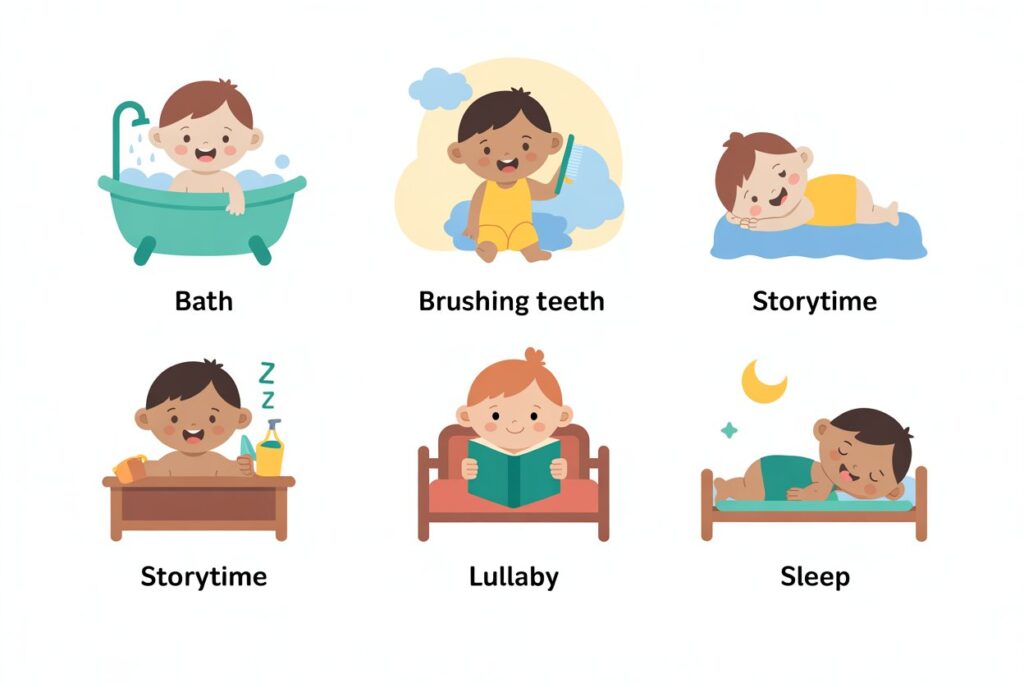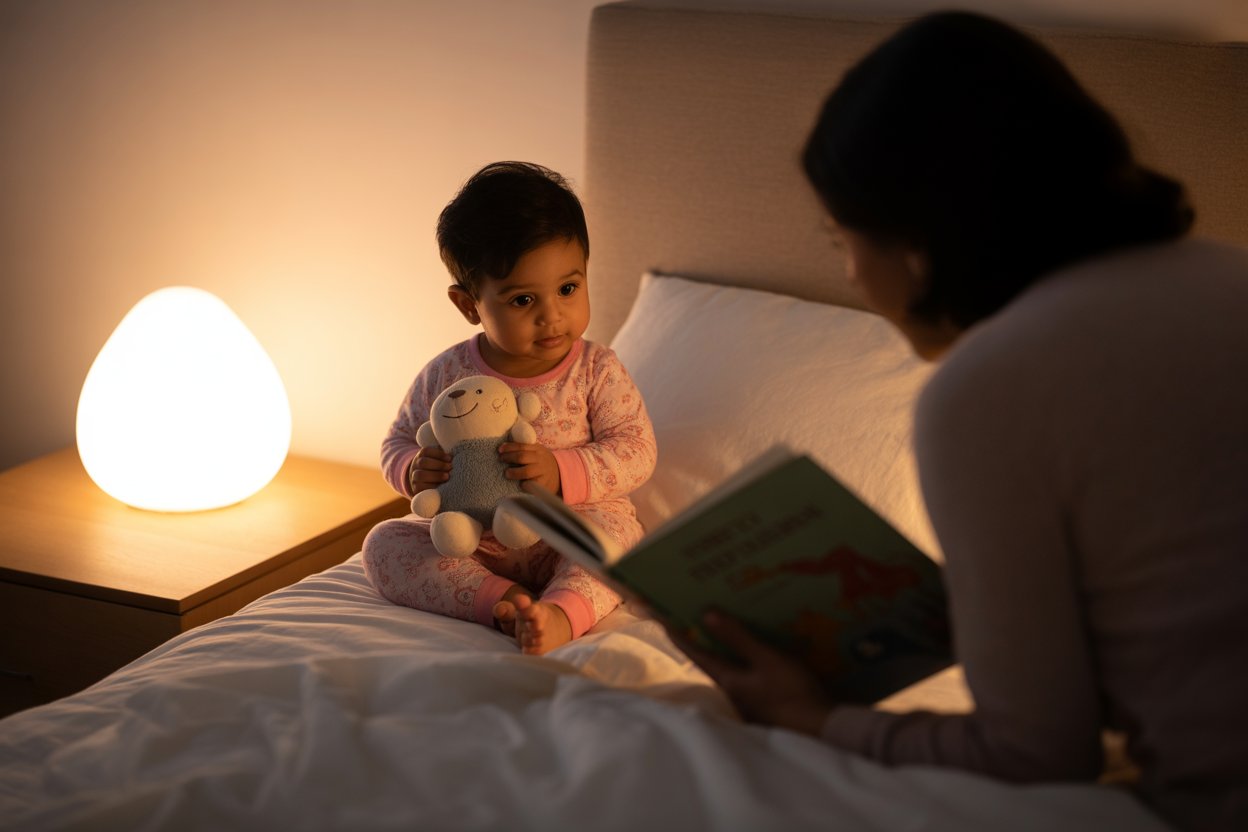Getting your toddler to sleep on time can sometimes feel like a nightly tug-of-war. Their boundless energy, curiosity, and occasional separation anxiety can make bedtime a stressful experience for both parents and children. But with a consistent and simple bedtime routine, you can transform these nightly struggles into calm, predictable, and comforting moments for your little one. A bedtime routine for toddlers not only helps toddlers fall asleep faster but also promotes better sleep quality, emotional security, and even healthy habits that will benefit them long-term.
Simple 3-Step Bedtime Routine for Toddlers
Step 1: Wind Down with a Calm Activity (10–15 minutes)
Begin the bedtime routine by helping your toddler transition from the busyness of the day to a calm state. This could include a warm bath, quiet play with soft toys, or listening to gentle music. Dim the lights in the room and reduce noise to signal that it’s time to relax. This step sets the tone for sleep and helps your child’s body start producing melatonin, the sleep hormone.
Step 2: Hygiene and Comfort (5–10 minutes)
Next, focus on hygiene and comfort. Brush your toddler’s teeth, change them into cozy pajamas, and offer a small, calming snack if needed (like warm milk). Incorporate a soothing ritual, such as a gentle massage or cuddling with a favorite blanket or stuffed toy. This step reassures your toddler and signals that bedtime is approaching.
Step 3: Storytime and Sleep (10–15 minutes)
Finish the routine with a short story, lullaby, or quiet conversation about the day. Keep interactions calm and predictable, allowing your toddler to lie down drowsy but awake. This encourages self-soothing and teaches your child to associate the bed with sleep. Once the story or lullaby is finished, tuck your toddler in and offer gentle reassurance before leaving the room.

Why a Bedtime Routine Matters
Toddlers thrive on routine. Their young brains crave predictability, and knowing what comes next helps them feel safe and secure. When children follow a consistent bedtime routine, they learn to associate certain activities with sleep, making it easier for them to wind down. Research shows that children with regular routines fall asleep more quickly, wake up less often during the night, and display improved behavior and mood during the day. A bedtime routine also provides an opportunity for bonding. Sharing quiet moments, like reading a story or singing a lullaby, creates a strong emotional connection and reassures your child that bedtime is a safe and loving experience.
Step 1: Choose a Consistent Bedtime
The first step in creating a successful bedtime routine for toddlers is choosing a regular bedtime. Consistency is key because toddlers’ bodies rely on a predictable schedule to regulate their internal clocks. For toddlers aged 1–2 years, the recommended total sleep is 11–14 hours, including naps, while children aged 3–5 years typically need 10–13 hours of sleep. Pick a bedtime that aligns with your family’s daily schedule and stick to it as closely as possible, even on weekends. A consistent bedtime not only helps your child fall asleep more easily but also prevents them from becoming overtired, which can actually make it harder for them to settle down at night.
Step 2: Create a Calm Environment
The environment in which your toddler sleeps plays a crucial role in helping them relax. Before bedtime, start by dimming the lights in the house about 30–60 minutes beforehand. Bright lights can interfere with the natural production of melatonin, the hormone responsible for sleep. Minimize noise, or consider playing soft background music or white noise to soothe your child.
Maintaining a comfortable room temperature is also important; a room that is too hot or too cold can disturb sleep. Finally, avoid screen time from televisions, tablets, or smartphones during this wind-down period. The blue light emitted from screens can interfere with your child’s ability to fall asleep and stay asleep. A calm, quiet, and cozy environment signals to your toddler that the day is ending and helps them transition into sleep mode.
Step 3: Introduce a Predictable Sequence of Activities
A simple, consistent sequence of bedtime activities helps toddlers anticipate what comes next, reducing resistance and fussiness. Keep the routine short and simple, with four to six steps, and follow the same order every night. A typical sequence might start with a warm bath. Bath time is naturally relaxing and serves as the first cue that bedtime is approaching. Next, brushing teeth reinforces good dental hygiene habits and signals another step toward winding down.
Following this, reading a short story or sharing a few quiet moments together provides comfort and fosters language development. Finally, a cuddle, lullaby, or calm conversation helps your toddler feel safe, loved, and ready for bed. Completing this routine with a favorite blanket or stuffed toy reinforces a sense of security. When toddlers know what to expect each night, bedtime becomes less of a struggle and more of a predictable, comforting experience.
Step 4: Keep the Routine Short and Manageable
Toddlers have short attention spans, so long or complicated bedtime routines can be counterproductive. Aim for a routine that lasts 20–30 minutes. Short routines are easier for toddlers to follow and help them feel calm rather than overstimulated. If your child is particularly fussy, you can skip non-essential steps or gradually introduce new activities over time. Keeping the routine simple ensures that bedtime remains stress-free and achievable, even on nights when your toddler is especially energetic.
Step 5: Encourage Self-Soothing
Helping your toddler learn to fall asleep independently is an important part of a bedtime routine. This teaches them to self-soothe, improves sleep quality, and reduces frequent night wakings. Place your toddler in bed while they are drowsy but still awake, so they associate the bed with falling asleep rather than being comforted by your presence. Use a consistent phrase like, “Goodnight, sleep tight,” or a gentle pat to signal that it’s time to sleep. Over time, your child will learn to calm themselves, giving them a sense of independence and making bedtime smoother for both of you.
Step 6: Handle Night Wakings Calmly
Night wakings are a normal part of toddler development. When your child wakes up in the middle of the night, respond calmly and quietly. Avoid turning on bright lights or engaging in play, as this may signal that it’s time to be awake. Instead, offer gentle reassurance with a soft voice or brief cuddle. Keep interactions minimal so your toddler understands that nighttime is for sleeping. Consistency in handling night wakings helps toddlers learn that it’s safe to sleep alone and reduces the likelihood of prolonged wake-ups.
Step 7: Adjust and Personalize
While consistency is important, every child is unique, and your bedtime routine may need occasional adjustments. You might need to slightly tweak the timing if your toddler is overtired or resisting sleep. Modify activities to match your child’s interests — for example, swapping storytime for quiet puzzles if that calms them more effectively. Life events like travel, illness, or family gatherings may disrupt the routine temporarily, and that’s okay. The key is to return to the consistent routine as soon as possible, reinforcing a sense of normalcy and predictability.
Quick Tips for Success
- Begin winding down 30–60 minutes before bedtime to signal that the day is ending.
- Avoid sugary snacks or caffeinated drinks close to bedtime, as they can interfere with sleep.
- Use a nightlight if your toddler is afraid of the dark, creating a comforting environment.
- Praise your toddler for following the routine to reinforce positive behavior and build bedtime confidence.
Bottom Line
A simple, consistent bedtime routine for toddlers can make nights calmer, happier, and less stressful for both toddlers and parents. By creating a soothing environment, establishing predictable activities, and encouraging self-soothing, you help your child sleep better, feel secure, and develop lifelong healthy sleep habits. Over time, bedtime becomes a cherished moment of connection and calm rather than a nightly struggle.




